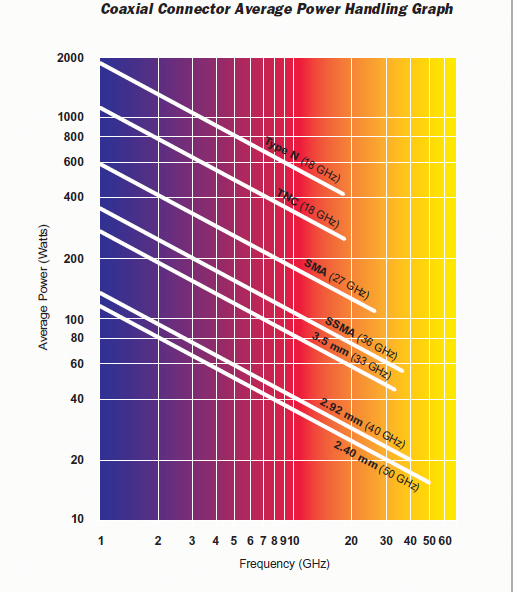In recent years, with the rapid development of wireless communication and radar technology, in order to improve the transmission distance of the system, it is necessary to increase the transmission power of the system. As part of the entire microwave system, RF coaxial connectors need to be able to withstand the transmission requirements of high power capabilities. At the same time, RF engineers also need to frequently conduct high-power tests and measurements, and microwave devices/components used for various tests also need to be able to withstand high power. What factors affect the power capacity of RF coaxial connectors? Lets come look

●Connector size
For RF signals of the same frequency, larger connectors have greater power tolerance. For example, the size of the connector pinhole is related to the current capacity of the connector, which is directly related to the power. Among various commonly used RF coaxial connectors, 7/16 (DIN), 4.3-10, and N-type connectors are relatively large in size, and the corresponding pinhole sizes are also large. Generally, the power tolerance of N-type connectors is about SMA 3-4 times. In addition, N-type connectors are more commonly used, which is why most passive components such as attenuators and loads above 200W are N-type connectors.
●Working frequency
The power tolerance of RF coaxial connectors will decrease as the signal frequency increases. Changes in the transmission signal frequency directly lead to changes in loss and voltage standing wave ratio, thus affecting the transmission power capacity and skin effect. For example, a general SMA connector can withstand about 500W of power at 2GHz, and the average power can withstand less than 100W at 18GHz.
●Voltage standing wave ratio
The RF connector specifies a certain electrical length during design. In a limited-length line, when the characteristic impedance and load impedance are not equal, a part of the voltage and current from the load end are reflected back to the power side, which is called a wave. Reflected waves; voltage and current from the source to the load are called incident waves. The resultant wave of the incident wave and the reflected wave is called a standing wave. The ratio of the maximum voltage value and the minimum value of the standing wave is called the voltage standing wave ratio (it can also be the standing wave coefficient). The reflected wave occupies the channel capacity space, causing the transmission power capacity to be reduced.
●Insertion loss
Insertion loss (IL) refers to the loss of power on the line due to the introduction of RF connectors. Defined as the ratio of output power to input power. There are many factors that increase connector insertion loss, mainly caused by: mismatch of characteristic impedance, assembly accuracy error, mating end face gap, axis tilt, lateral offset, eccentricity, processing accuracy and electroplating, etc. Due to the existence of losses, there is a difference between input and output power, which will also affect the power withstanding.
●Altitude air pressure
Changes in air pressure cause changes in the dielectric constant of the air segment, and at low pressure, the air is easily ionized to produce corona. The higher the altitude, the lower the air pressure and the smaller the power capacity.
●Contact resistance
The contact resistance of an RF connector refers to the resistance of the contact points of the inner and outer conductors when the connector is mated. It is generally in the milliohm level, and the value should be as small as possible. It mainly assesses the mechanical properties of the contacts, and the effects of body resistance and solder joint resistance should be removed during measurement. The existence of contact resistance will cause the contacts to heat up, making it difficult to transmit larger power microwave signals.
●Joint materials
The same type of connector, using different materials, will have different power tolerance.
In general, for the power of the antenna, consider the power of itself and the power of the connector. If there is a need for high power, you can customize a stainless steel connector, and 400W-500W is no problem.
E-mail:info@rf-miso.com
Phone:0086-028-82695327
Website:www.rf-miso.com
Post time: Oct-12-2023







